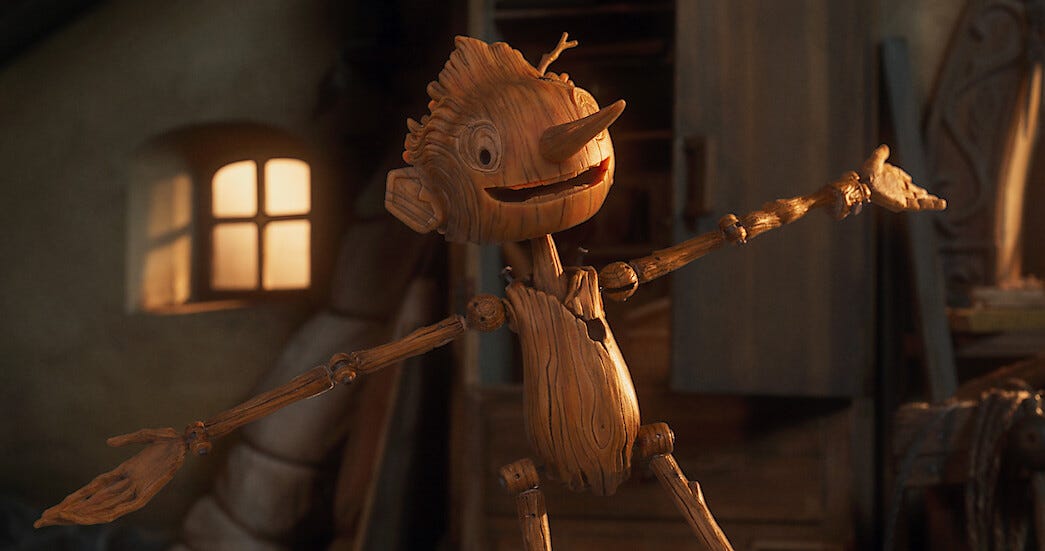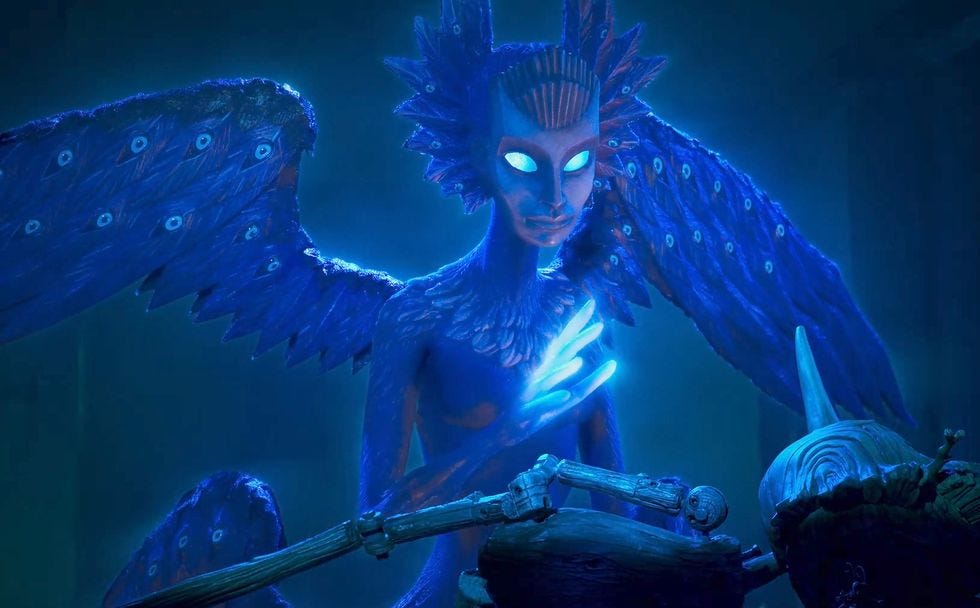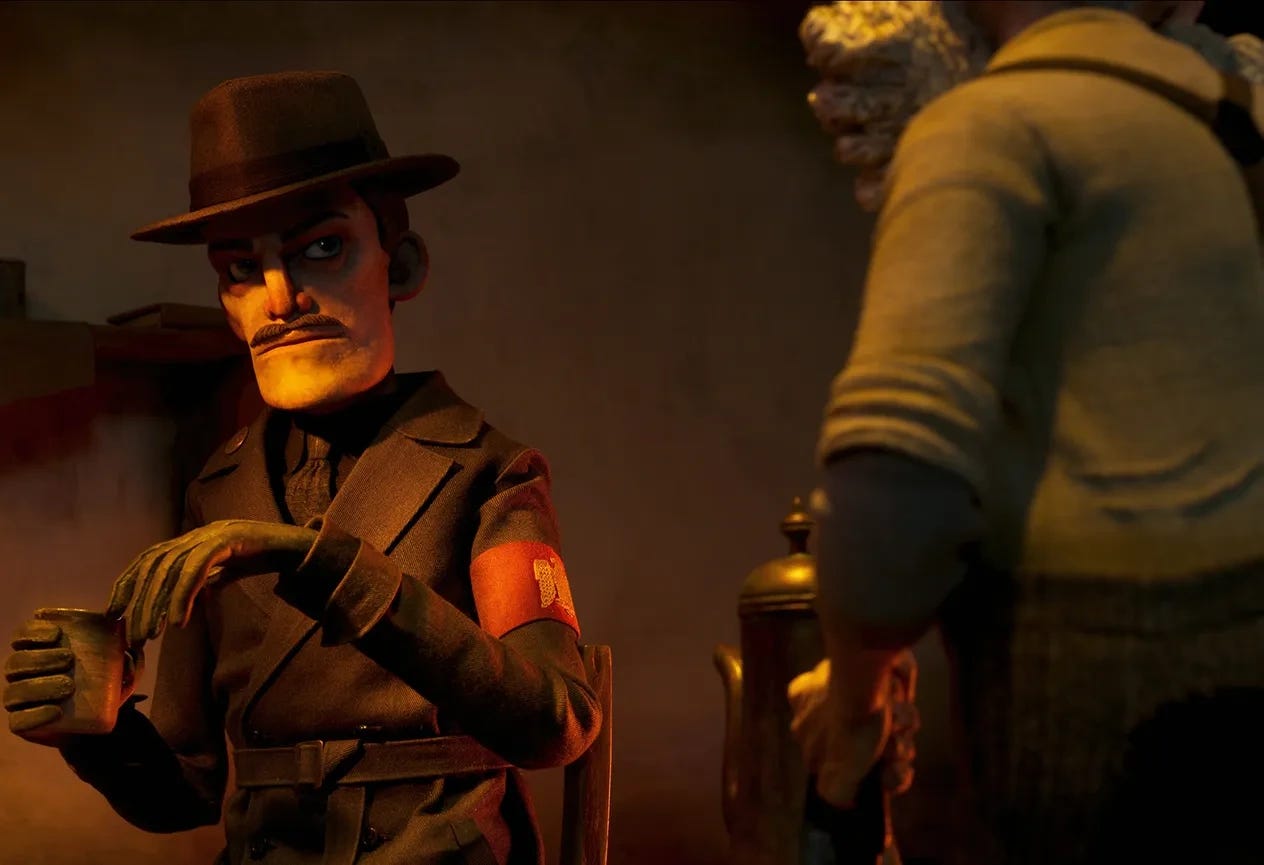Guillermo del Toro’s Pinocchio and the Virtue of Disobedience
This bittersweet animated beauty offers a roadmap for living through dark times.
We are living in the waning days of 2022 or, as it will surely be remembered, the Year of Pinocchio.
The famous wooden boy first appeared in a series of adventures written by Italian children’s author Carlo Collodi in the 1880s. The Adventures of Pinocchio has been adapted numerous times since, with three new films from this year alone.
First there was Pinocchio: A True Story, a Russian animated film that went viral for its bizarre leading performance from 90s comic Pauly Shore. This past September saw the release of Robert Zemeckis’ live action remake of Disney’s Pinocchio. This may sound like oversaturation, but I would gladly accept a dozen sub-par Pinocchio films a year if even one of them was as good as Netflix’s new release.
Earlier this month, director Guillermo del Toro made a late entry in the Great Pinocchio Race of 2022 with a stop motion musical adaptation. This is del Toro’s first stop motion feature, brought to life with co-director Mark Gustafson (animation director of Fantastic Mr. Fox), and co-written by Over the Garden Wall creator Patrick McHale. Using actual puppets to tell the story of Pinocchio is not only clever, it distinguishes Guillermo del Toro’s Pinocchio from its predecessors. Well-crafted animation aside, del Toro’s trademark blend of wonder and horror brings new life to Collodi’s classic fairy tale.
The film opens with a prologue set in a little Italian village during World War I. The woodcarver Geppetto (voiced by the brilliant character actor David Bradley) puts the finishing touches on a magnificent wooden crucifix for his local church, accompanied by his young son Carlo. It’s a touching scene, tragically interrupted by the sound of bombers overhead. Geppetto escapes with his life, but Carlo is killed when a stray bomb hits the church.
Twenty years pass, but time does nothing to heal these wounds. Carlo is dead and buried, the crucifix remains horribly damaged by the explosion, and Geppetto has become the town drunk. One stormy night, in a fit of drunken grief, he chops down a pine tree and builds a wooden boy to replace his son. It’s a grim sequence that alludes to Frankenstein as the grief-stricken father attempts to defy death itself. Creation isn’t always pretty, the film reminds us. Art can be an act of devotion, as it once was for Geppetto, but it can also be a raw expression of grief.
Geppetto’s hacking and sawing attracts the attention of a wood sprite (voiced by Tilda Swinton, ethereal as ever), the film’s equivalent of the Blue Fairy. The creative team has completely reimagined the character, opting for an angelic chimera that resembles something from the Book of Ezekiel more than a traditional fairy. Taking pity on the lonely old man, the sprite bestows life upon his wooden boy. She names this living puppet Pinocchio and appoints him as Geppetto’s companion.
Here we also meet Sebastian J. Cricket, brought to flamboyant life by Ewan McGregor. A former resident of the pine tree that became Pinocchio’s body, the talking cricket protests the loss of his home. The sprite proposes a deal to pacify him. If he serves as Pinocchio’s moral guide, she will grant him one wish: fame, riches, whatever a talking cricket might desire.
Pinocchio proves to be a difficult pupil for Sebastian. He is pure Freudian id, pursuing his every whim with no regard for the consequences. We see this in his first song “Everything Is New To Me” (young actor Gregory Mann voices the part wonderfully), when the precocious puppet trashes Geppetto’s workshop and demands to know the names and functions of various everyday objects. Every authority figure in Pinocchio’s life tries to teach him obedience. To Geppetto and Sebastian, obedience means going to school and treating others with respect. But as Pinocchio soon learns, not every authority figure is so benevolent.
Del Toro’s film has more in common with Disney’s Pinocchio than I anticipated. The original film picked a few characters and episodes from Collodi’s stories and cobbled them together into a single narrative. This retelling utilizes most of the same material, with one very notable exception.
Disney’s Pinocchio contains a memorable sequence set on Pleasure Island, a seedy amusement park where young boys are invited to eat, drink, and smoke to their hearts’ content. Of course, Pleasure Island turns out to be a cover for a far more sinister operation, where boys are turned into donkeys and sold into hard labor. While the Disney film warns against the vices of overindulgence, del Toro’s film explores much darker territory.
If you haven’t seen Guillermo del Toro’s Pinocchio and would like to go in relatively unspoiled, now’s the perfect time! You can come back and read the rest later. Or don’t, I won’t presume to be an authority figure for you.
Like del Toro’s earlier film Pan’s Labyrinth, Pinocchio blends fairy tale magic with grim historical reality. The film moves the setting from the 19th century to Mussolini’s Italy. While in the clutches of a sleazy circus owner, Pinocchio is forced to perform for the fascist dictator. Instead of the jingoistic song he’s rehearsed, he launches into a shockingly childish and scatological diss track.
After humiliating Mussolini, Pinocchio is sent to a military training camp by the Podesta, a fascist government official. Rather than turning unsuspecting youths into donkeys, the Podesta shapes them into compliant child soldiers for Mussolini’s regime. He is in the business of turning real boys into puppets. Always a puppet but never a bootlicker, Pinocchio is more interested in making friends than learning how to fight. In the context of a fascist regime, his capacity for disobedience becomes a virtue.
If obedience can be evil, what does it mean to be good? Sebastian J. Cricket does his best to answer that question before the film is over. After saving Geppetto from a sea monster, Pinocchio sacrifices his life to save his father from drowning. In the film’s most painful scene since the death of Carlo, Geppetto cradles the lifeless puppet in his arms, struggling to accept that Pinocchio is truly gone. The wood sprite returns to console him, but Sebastian has no patience for her platitudes.
He reminds the sprite of their bargain, that she must grant his wish in exchange for his helping Pinocchio to be a good boy. Everything hinges on this question: was Pinocchio good? For all his mistakes, the cricket argues, Pinocchio tried his best and gave everything he had. This satisfies the wood sprite, and Sebastian uses his one wish to restore Pinocchio’s life. In this retelling, Pinocchio never becomes flesh and blood. He becomes a real boy through his love for Geppetto, no magical transformation necessary.
Guillermo del Toro’s Pinocchio is a film about recognizing the humanity of the people around us. Its characters are flawed and messy, but their warmth and generosity outweigh their faults. They live in a world marred by war and exploitation, where obedience and goodness aren’t always the same thing. Del Toro and his collaborators prove that even the most familiar fairy tales are worth revisiting. Now streaming on Netflix, Pinocchio is a wonderful modernization of a classic fable.



